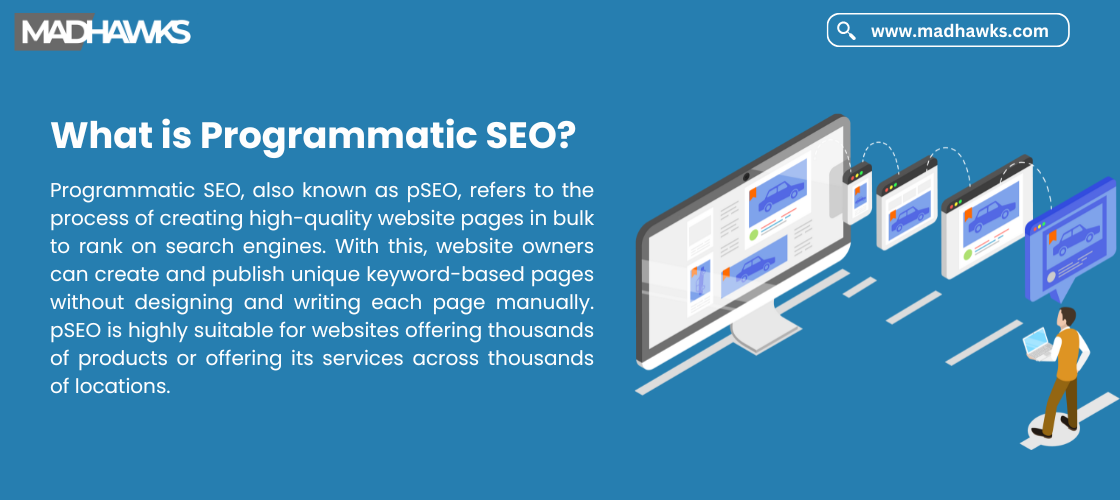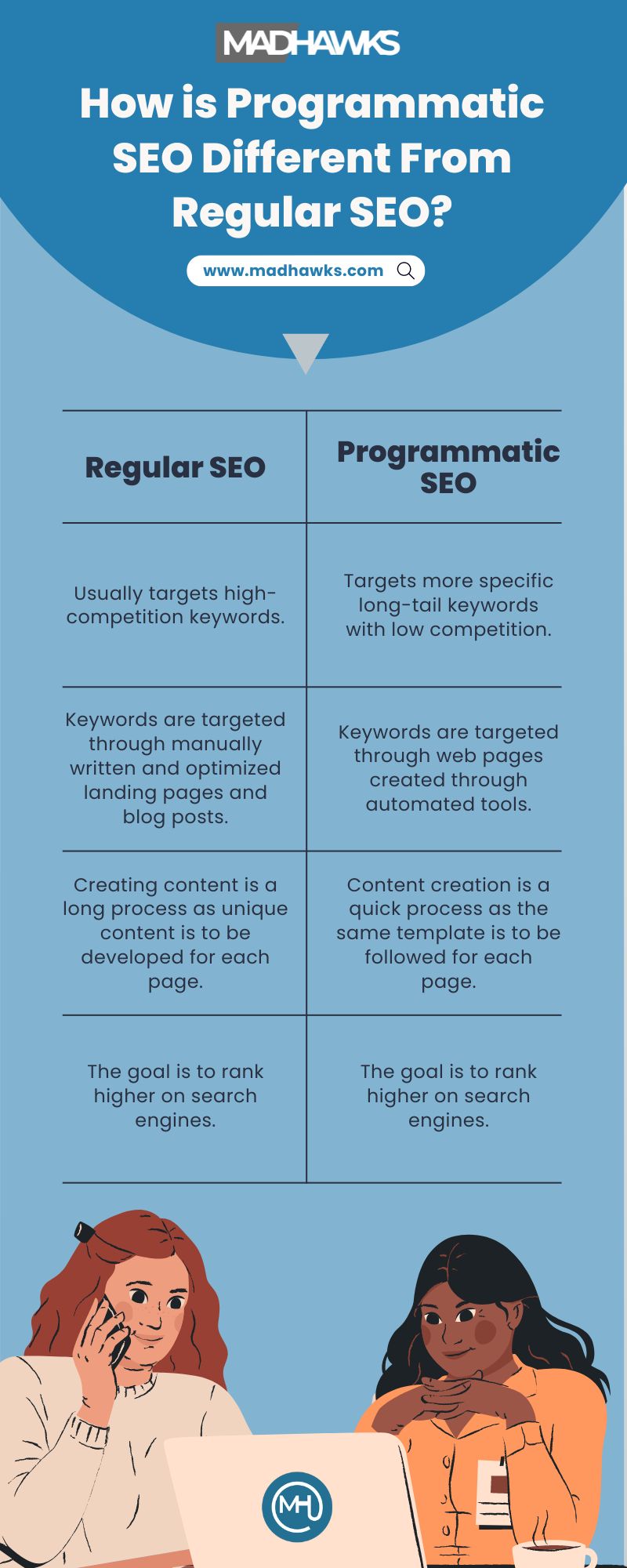Programmatic SEO: Here’s Everything You Need To Know
Posted By Gaurav | 02-May-2024 | Search Engine OptimizationYou must have come across some websites that have thousands of pages and you see their results for every location or every product you search for. Ever wonder how they manage to build so many web pages? It’s Programmatic SEO that makes it possible. Let’s discuss it in more detail through this blog!

In today’s highly competitive world, you cannot rank your website just by writing blog posts around each specific keyword, especially when you offer thousands of products or services or target thousands of locations with your services. It requires a different strategy and programmatic SEO provides you with that strategy. Websites like Amazon, TripAdvisor, Zapier, etc, which have thousands or probably millions of webpages use programmatic SEO. It is an SEO strategy different from regular SEO and makes use of automated tools to build webpages on a large scale.
You must be familiar with the regular SEO practices, where you need to create long-form content for each web page or blog post targeting specific keywords. But programmatic AI SEO works quite differently. Let us understand the concept of programmatic SEO from scratch and discuss how you can successfully implement it for your website:
What is Programmatic SEO?
 Programmatic SEO, also known as pSEO, refers to the process of creating high-quality website pages in bulk to rank on search engines. With this, website owners can create and publish unique keyword-based pages without designing and writing each page manually. pSEO is highly suitable for websites offering thousands of products or offering its services across thousands of locations.
Programmatic SEO, also known as pSEO, refers to the process of creating high-quality website pages in bulk to rank on search engines. With this, website owners can create and publish unique keyword-based pages without designing and writing each page manually. pSEO is highly suitable for websites offering thousands of products or offering its services across thousands of locations.
These pages are created using a pre-specified template and a database containing relevant information like product prices, specifications, and others. Each page has the same template and elements. Once the template is finalized and one page is created, every other page is made using the same template with an automated tool. Programmatic SEO can be used to create any number of pages. Be it a website of 100 pages or a million-page website, the pages can be generated using programmatic SEO.
The purpose is to target hundreds or thousands of low-competition long-tail keywords to improve a website’s visibility on SERPs (Search Engine Result Pages).
Examples of Programmatic SEO
Many top market players like Amazon have been using programmatic SEO to create their product pages. It's not even practically possible to create such a large number of pages manually. So what these websites do is simply create a standard format, build a database of relevant information, and leverage programmatic SEO to create similar pages on a large scale. Some examples of programmatic SEO websites include:
- Zapier: To create ‘How to connect X to Y’ pages, where X and Y are two different apps.
- Canva: To create ‘XYZ design template’ pages.
- Zillow: To create ‘X homes for sales’ pages, where X is a location.
- Yelp: To create ‘Best restaurants in X’ pages, where X is the location.
Ensuring That You Are Creating High-Quality Pages and Not Spam
With programmatic SEO, you can either end up having a website with thousands of high-quality web pages or thousands of spam pieces. pSEO can help you grow your website really fast, but you need to be careful about the quality of your pages. It should not look like spam, but like a genuine page that fulfills users’ search intent. Many sites that use programmatic SEO to create bulk pages often end up having a risk of thin content on their website, i.e. web pages that offer almost no value to the searchers. And such pages will definitely be considered spam by Google or other search engines.
In order to ensure good content quality in your programmatic pages, you need to be very careful with the relevancy and accuracy of data. Above-mentioned websites like Zapier are successfully creating good-quality web pages with programmatic SEO because their data is relevant to the product and is presented in such a format that it is easily understood by the users. This is what you need to ensure when using programmatic SEO for your website. There is a very thin line between quality programmatic websites and spammy programmatic websites. Make sure that you stay within the first one.
How is Programmatic SEO Different From Regular SEO?

Although the goal of programmatic SEO is the same as that of regular SEO. It is to generate more organic traffic. The difference lies in how the two work.
Regular SEO: It is a long-term strategy that is focused on driving more traffic and achieving higher rankings on Google. It majorly focuses on targeting specific high-competition keywords by publishing landing pages and blog posts around them. Creating content is a much more time-consuming process in regular SEO as content is written and optimized for each page manually.
Programmatic SEO: The goal of programmatic SEO is also to rank on search engines and drive more traffic to the website. It uses a standard template and a database of relevant information to create web pages on a large scale. In this, mainly low-competition long-tail keywords are targeted to drive traffic to a particular page. It is a less time-consuming process as the creation of web pages is automated and is done using just one template and one database.
Programmatic SEO: Pros and Cons
Programmatic SEO, when used and implemented wisely, can help you grow your website. On the other hand, it can also have negative impacts on your website if you don’t take care of the quality and relevancy of data. Like every other method, programmatic SEO also has its own advantages and disadvantages as listed below:
Advantages:
Below are some of the advantages of Programmatic SEO:
- Once you build a standard landing page template, it is easy to create web pages on a large scale.
- You can target generic as well as more specific long-tail keywords with a single page.
- It helps you increase your site’s visibility on search engines by ranking for low-competition keywords.
- By targeting more specific keywords, you can target a more relevant audience who are more likely to be interested in your products or services.
- Higher traffic and visibility increase backlink opportunities for your website.
Disadvantages:
Below are some of the disadvantages of Programmatic SEO:
- Creating programmatic websites might require coding skills or higher upfront costs in the case of no-code software.
- Increases the risk of low-quality or duplicate content, which is against Google’s policies.
- Indexing might become difficult as search engines might not be able to properly crawl all your web pages.
- The quality of sites highly depends on the relevancy of data sources.
- Programmatic sites require regular monitoring and higher maintenance.
The Foundations Stones of Programmatic SEO
The success of a programmatic SEO Services strategy largely depends on what keyword you target, how relevant your data sources are, and how well the user experience your site offers. Let us discuss these three pillars of programmatic SEO in more detail:
1. Specific Low-Competition Keywords
With programmatic SEO, one should aim to target more specific keywords that are less competitive. This is what sites like Zapier, TripAdvisor, etc, do to rank their programmatic web pages. You can use keyword research tools like Semrush to measure the competitiveness of the keywords you are using. Metrics like KD (Keyword Difficulty) help you understand this. The lower the KD, the lower the competition. Therefore, you need to focus on keywords having low KD percentage, preferably below 29%.
2. User Search Intent
You need to ensure that your programmatic site is fulfilling the search intent of the users. Search intent refers to the goal that the users expect to achieve when they visit your web page. If they don’t get what they are looking for, it means the website didn’t fulfill their search intent. There are four major types of search intents:
- Informational: When the user’s goal is to gain more knowledge on a topic.
- Navigational: When the user is looking for a specific page or the steps to reach that page.
- Transactional: When the user is trying to make a purchase or perform any such action.
- Commercial: When the user is trying to do research about a product or service before making a purchase.
Usually, programmatic sites target audiences with commercial or transaction search intents. Fulfilling the search intent of users at the very beginning of your page gives users a reason to stay on your page and improves their experience of your website.
3. User Experience
With all the recent updates introduced by Google, we all know it very well that Google now prioritizes websites that offer good user experience. Good user experience is what encourages users to stay on your website and become returning visitors. It is also the most significant factor determining whether a website visitor will convert or not.
Therefore, it is crucial to ensure that your programmatic web pages have good-quality content, a fast loading speed, and an easy-to-understand user interface. What you can do is create bulk landing pages using programmatic tools, but get the content thoroughly written or edited by a human writer.
Your Step-by-Step Guide to Implementing a Programmatic SEO Strategy
To successfully implement a programmatic SEO strategy and make the most out of it, you can follow the below-listed steps:
1. Do Niche and Competitor Research
In order to finalize the format of your landing pages, do some proper research on your niche. See how other websites in your specific niche or your competitors have created their landing pages. This will help you understand what works in your specific niche. You can take inspiration from them and generate your own ideas accordingly.
Think about what your audience looks like and how are you planning to target them, i.e. with different use cases of the same products, different locations, or anything that is relevant to your business and audience base. You can find your competitors using online competitor analysis tools, which will provide you with a list of all the sites targeting the same keywords as yours. Look at those websites and see how you can set your business apart.
2. Identify Head Terms and Modifiers
Before conducting the final keyword research, you need to find relevant head terms and modifiers to streamline your programmatic SEO strategy. Head terms refer to the main category keywords related to your specific niche and modifiers are the terms used to turn these main keywords into long-tail keywords. This is how you can come up with relevant long-tail keywords that are less competitive and target just the right set of audiences.
For example, suppose you run a hotel chain and want to target different locations across India. You can use the head term ‘best hotels’ and modifier ‘in Gurugram’ to come up with the long tail keyword ‘best hotels in Gurgugram.’
Or, if the budget-friendly price is your USP, you can use the head term ‘best hotels’ and modifiers ‘in Gurugram’ and ‘under x’ (where x is a particular amount). This will make a long tail keyword ‘best hotels in Gurugram under x,’ which will help you target a more relevant set of audiences looking for hotels in a particular location and under a specific budget.
3. Pick The Long-Tail Keywords You Want to Target
Once you find relevant head terms and modifiers, you can combine them to create a long list of keywords. But, not all of these keywords will fulfill the users’ search intent. To find the most relevant keywords with high-ranking opportunities, use a keyword research tool and look for search terms with low KD. You can find these search terms by applying relevant filters, setting the KD to ‘easy’, and selecting the relevant ‘intent.’
If you are targeting users with transactional as well as commercial search intent. Repeat the process twice by selecting one intent at a time and applying the filter to get a list of relevant keywords. You can create more keywords around these search terms based on the locations of the types of audiences you are targeting. If any keyword doesn’t allow you to create more keywords around it, just discard it for programmatic SEO.
4. Build a Template That Will Be Used for All The Landing Pages
This is the step where you need to be very careful with everything. You will now need to build a standard template that will be used to create thousands of web pages. So, the layout of this template should be created in such a way that it directly appeals to the target audience. The layout will be the same throughout your web pages, but the information needs to be different if you want to stick to Google’s guidelines and don’t want to be penalized.
The content plays a major role here. The design of the template should depend on what elements you want to be included in the page, such as location, prices, reviews, etc. Once you have a clear idea of what type of template you want to create, you can follow the below steps:
- Choose a website page builder, where you can get multiple template options to choose from. Even if you have no prior coding knowledge, you can build a template using no-code website builders.
- The next step would be to choose a database, where you have stored all the information to be incorporated into these landing pages. This database can be as simple as an Excel sheet.
- Use a copywriting tool to write copies for these pages, but make sure that you get the content of these pages edited by humans later on.
- Use integration tools to integrate your database with your website builder software and let automation create all your landing pages.
5. Publish Pages and Get Indexed
Indexing becomes a challenge when you are using a programmatic SEO strategy to improve your website’s rankings. It is because search engines might not be able to index so many pages in just a day or two. Understand that everything happens at scale. If your indexing is less than 30%, don’t panic as these pages will most probably be indexed. As programmatic pages look similar, most of them might be crawled but not indexed. So, what you can do is just ensure that there is something new on every page that helps search engines understand that these pages contain different information.
If you are doing that and you know that you are bringing something new to SERPs with every page, use the following strategies to improve your site’s indexing rate:
- Internal linking matters even more in programmatic SEO. Build a good internal linking structure and find the best linking opportunities for each individual page.
- Create HTML sitemaps. You can use the flow having category> sub-category>pages for better internal linking and better crawlability of your pages. This will increase the chances of your pages being indexed.
6. Improve User Experience
As mentioned above, Google prioritizes websites that offer a good user experience. So, in order to improve your website’s visibility, you need to ensure that your web pages fulfill user expectations. The content and information available on your web page should do justice to the meta title, that encouraged users to click on the URL and visit your website. Make sure that your web pages have a visually appealing design and an easy-to-understand format. Also, users should be able to navigate through different pages if they want to.
Apart from this, well-written content and clear CTA are some important factors determining the user experience of your website. Make sure that you monitor all the pages after they’ve been launched and make sure that there are no errors.
What Our SEO Experts Have to Say?
While programmatic SEO is the best approach to creating web pages on a large scale, you must keep in mind that it cannot replace regular SEO. The best SEO strategy is what follows regular and programmatic SEO alongside each other. When creating programmatic pages, make sure that you use relevant and reliable data sources in order to avoid making your pages look spammy.
Even if you are using a writing tool to create copies for your landing pages, make sure that you get these copies and reviewed and edited by your human writer once the pages are published. Monitoring these pages is extremely important to ensure that they fulfill users’ search intent. Also, if you are struggling to get your programmatic pages indexed, consider building a better internal linking structure and creating HTML sitemaps to help search engine crawlers discover your pages.
As mentioned earlier, there is a very thin line between high-quality programmatic sites and spammy programmatic sites. To make sure that you stay on the quality side, ensure that your database has relevant information. Each page adds some value to the users. For any further assistant with programmatic SEO or regular SEO, contact us today!
FAQs
1. How to do a programmatic SEO for a website?
Ans. You can do programmatic SEO for a website by following these steps:
- Do keyword research and expand your keyword lists by combining relevant head terms and modifiers.
- Create a standard template.
- Choose a website builder tool to create landing pages.
- Monitor the pages after they are published.
- Get the pages indexed.
- Focus on user experience by reviewing and improving the quality of content manually.
2. What are some real-world examples of programmatic SEO?
Ans. Some most popular examples of websites using programmatic SEO include Amazon, Zapier, TripAdvisor, Canva, Yelp, etc.
3. What are the benefits of a programmatic SEO strategy?
Ans. Some common benefits of a programmatic SEO strategy include:
- Allows you to create thousands of web pages using the same template and database
- The process is much faster than regular SEO
- Allows you to target more specific keywords and reach more relevant audiences
4. What is programmatic SEO and why your business needs it?
Ans. Programmatic SEO refers to the process of creating bulk web pages using a standard template and a database containing the relevant information. Businesses that offer thousands of products/services or target multiple locations need programmatic SEO as it’s not practically possible to create millions of web pages manually.
5. What is the difference between programmatic SEO and SEO?
Ans. Although both regular SEO and programmatic SEO have the same end goal (to get higher rankings), the way these two work makes them different from each other. Every landing page is designed and written manually in a regular SEO strategy. On the other hand, these pages are built based on a standard template and need not be written or designed manually in programmatic SEO.

